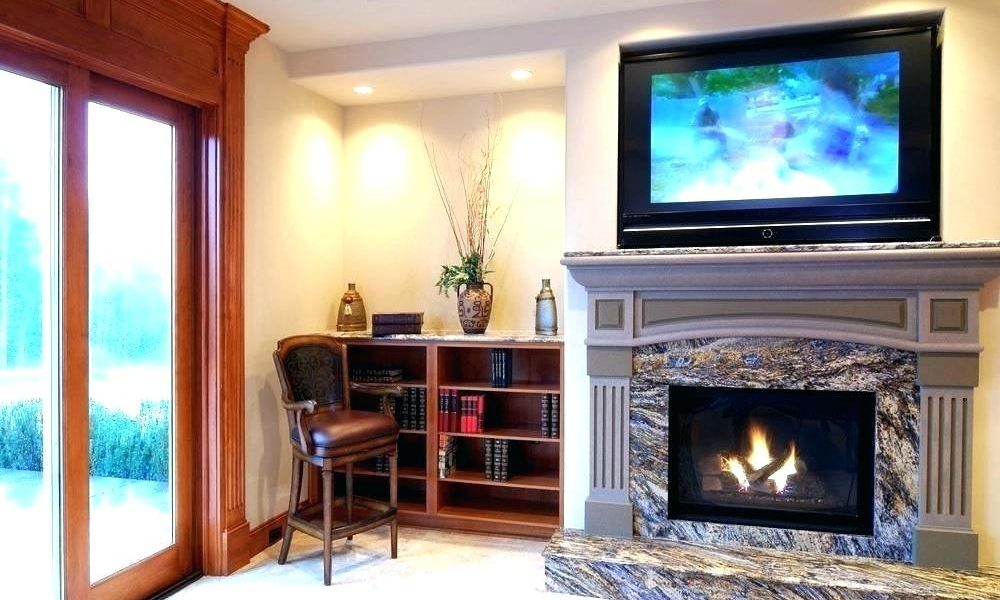Should You Mount Your TV Over Your Fireplace?
Few things are cozier than watching television next to a crackling fire. But what about when the TV itself is above the fireplace? Both seem to fit together. Plus, due to the layout of some homes, this often appears to be the best arrangement. But is it ever good practice to mount a TV over a fireplace, whether from the standpoint of viewing comfort or safety?
Why It’s a Bad Idea
Viewing Height and Angle Are Incorrect
Consult the instructions included with your TV for the correct height, angle, and distance you should maintain from the screen. Typically, the center of the screen should be at eye height when you are sitting and facing the screen. Unless the fireplace is especially low, its height will conflict with optimal viewing height for the TV.
Additionally, with the advent of 4K TVs, the optional viewing angle has increased. A standard 55-inch high-definition TV should be viewed no closer than 83 inches away. But due to the greater number of pixels displayed by 4K TVs, the recommended optional minimum distance is half of that (39 inches).
As distance decreases, the viewing angle increases. If you like viewing your screen as close as possible, the angle imposed by the fireplace will detract from your viewing experience. While a full motion articulating wall mount can help to angle the screen downward, you are still forced to tip your head back to see the screen.
Your Viewing Experience Is Compromised
True film lovers abhor distraction. Ambient light and background activity combine to take away from the best cinematic experience. The licking flames of even a modest fireplace represent both light and activity. If you value premium picture quality, a fireplace underneath the TV is not conducive to a peak cinematic experience.
Wood Fires May Affect the TV
With its crackle and smoke, an authentic wood fire is charming and romantic. But intense heat and smoke are bad for TVs that are mounted above them. Wood fires can put out as much as 60,000 BTUs (British Thermal Units) and can reach temperatures high enough to ignite creosote in the flue and start chimney fires. Since heat rises, any heat not vented up the chimney cascades over the front of the mantel and upward. If the heat doesn’t affect the TV, the smoke will.
Wiring and Mounting May Be Difficult
Brick, natural stone, manufactured veneer stone, and similar solid masonry fireplaces afford no below-surface room to run wires. As a result, the wires would need to be run on top of the surface. By most electrical codes, NM electrical cable cannot be surface-mounted. The only code-compliant alternative would be to run wires through surface-level conduit, hardly an attractive feature for any fireplace.

When to Mount Your TV Over the Fireplace
Cables and Jacks Are Located There
Houses and apartments are often built with recessed niches intended for TV placement. These niches also have an electrical outlet, Ethernet cable, and cable TV jack. In our increasingly wireless world, your WiFi TV may be free of the limitations of cable TV jacks and Ethernet cables. Still, many people tend to prefer the reliability and faster speeds of the Ethernet connection. If your home has a recessed niche above the fireplace with all of the connections you desire, there is no reason why you cannot place a TV there.
Room Space Is Tight
When you need to maximize your small living room and pack in as many functions as possible, you may want to mount the TV over the fireplace. Placing the TV in this area frees up wall space for other elements such as bookcases, furniture, or wall art. Small living rooms demand creative thinking to make everything fit together, and placing the TV over the fireplace may be one way to accomplish this.
You Have a Gas or Gel Fireplace
Over time, home fireplaces have increasingly become cooler. Intensely hot wood fires are becoming a thing of the past, as more communities enact air-quality restrictions and fewer wood fireplaces are being built. Natural gas fireplaces with inserts, particularly ventless gas fireplaces, are considerably cooler. At the low end of the temperature scale are gel fireplaces, which put out less heat than both wood and natural gas fireplaces.
